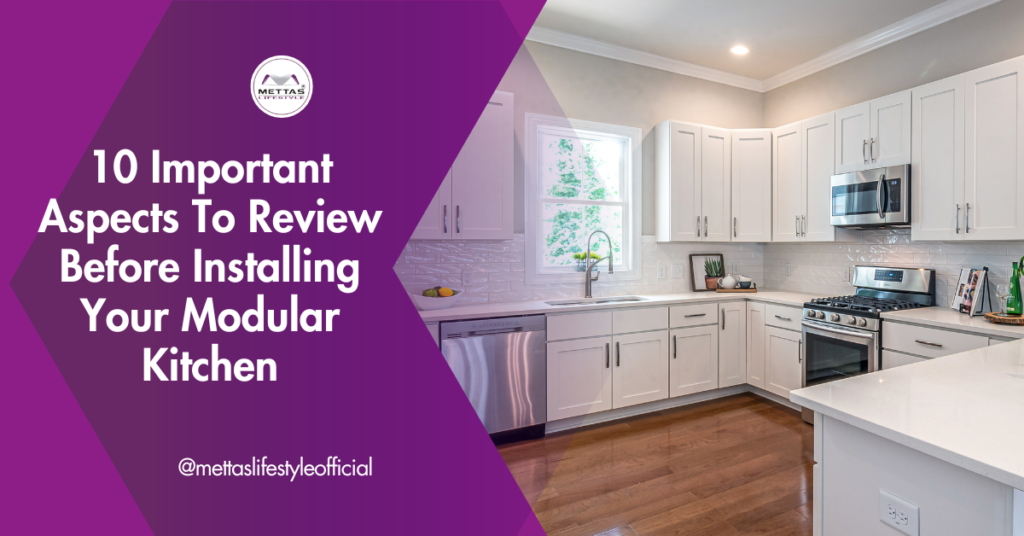

An interesting project for renovating your home that improves both practicality and appearance is installing your modular kitchen. To guarantee that the installation goes well, though, careful planning is essential. Here are ten crucial factors, each with a detailed sub-point, to think about before building your modular kitchen.
Table of Contents
Toggle1. Kitchen Layout For Installing Your Modular Kitchen

• Take precise measurements of your kitchen’s area.
• Select the appropriate arrangement (rectangular, L-shaped, U-shaped, etc.).
• Make sure it’s simple to travel between the cleaning, storage, and cooking areas.
• Steer clear of busy designs and give space efficiency a priority.
• Establish a productive workflow (work triangle) between the stove, sink, and refrigerator.
• Take into consideration the kitchen’s traffic flow and door swing.
• Make sure there is enough room for appliances like refrigerators and ovens.
• Take into account the prospect of upcoming additions or changes.
• Use tall cabinets to maximize vertical space.
• Steer clear of using cabinets to obstruct windows or natural light.
2. Storage Solutions
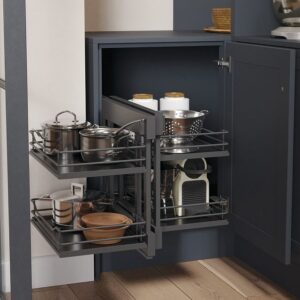
• Select specialized storage (pots, utensils, etc.) according on your needs.
• Provide pull-out drawers to make things easy to access.
• Make good use of corner space by placing pull-out or carousel units there.
• Construct tall units for bulk and pantry storage.
• When it comes to less-used things, think about overhead cabinets.
• Set aside room for specialized gadgets (such as a blender and microwave).
• Make sure that small kitchen tools and silverware are stored properly.
• For convenience, select drawers and cabinets with soft closures.
• To keep things organized, install drawer organizers.
• Make sure the storage is sturdy and resistant to moisture.
3. Materials Selection
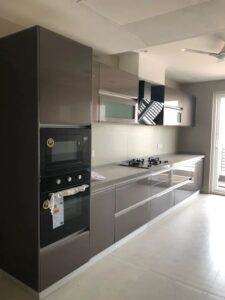
• Select sturdy, maintainable materials for cabinets.
• For base cabinets, choose MDF or plywood that can withstand moisture.
• For visual attractiveness, take into account finishes made of glass, laminate, or acrylic.
• Select solid surface, quartz, or granite for your counters.
• Verify if the materials are moisture- and heat-resistant.
• Examine countertop materials for resistance to stains and scratches.
• To avoid mishaps, install flooring with anti-skid tiles.
• Verify that the materials are simple to clean and maintain.
• Seek for sustainable and environmentally friendly material solutions.
• Select hinges and handles made of materials resistant against corrosion.
4. Lighting and Ventilation

• Installing an exhaust fan or chimney will help get rid of cooking smells.
• Make sure you have enough natural light by using windows.
• Make sure important areas like the stove and worktops have task lighting.
• For strong illumination and energy efficiency, use LED lights.
• Think about installing under-cabinet lights to lessen shadows.
• Select fixtures that are simple to maintain and clean.
• To prevent moisture buildup, make sure there is adequate airflow.
• Add ambient lighting to the kitchen to make it more bright overall.
• Use illumination that can be adjusted for various jobs.
• Lighting should be positioned close to prep areas to improve visibility.
5. Electrical and Plumbing Points

• Determine the precise placement of the dishwasher and sink.
• Make sure plumbing connections are easily accessible for maintenance.
• Place purifiers or filters in the vicinity of the sink.
• Set aside outlets for important appliances (microwave, refrigerator).
• Verify that there are sufficient plugs available for tiny gadgets.
• Install GFCI outlets close to water sources to ensure safety.
• Arrange hidden wires for a tidy appearance.
• Verify that the dishwasher and sink have adequate drainage systems.
• Make electrical and plumbing systems simple to maintain.
• Place position switches in easily accessible areas.
6. Integration of Appliances
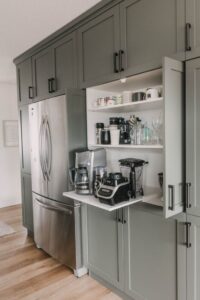
• Set aside room for the oven, refrigerator, and microwave, among other necessities.
• Make sure microwaves and other equipment have enough airflow.
• For a seamless appearance, select built-in appliances.
• Arrange piping and wiring for washing machines and dishwashers.
• Make sure there is enough room for the refrigerator door to open completely.
• To save on electricity, choose appliances that are energy-efficient.
• For simple access, install appliances at an ergonomic height.
• Arrange for extra appliances in the future (mixer, air fryer).
• Verify that the equipment complement the kitchen’s stylish layout.
• Put appliances that are used regularly in easily accessible places
7. Countertop Height

• Verify that the countertop is the ideal working height, which is often between 34 and 36 inches.
• When choosing countertop height, take the lead cook’s height into account.
• To prevent strain, allow for an ergonomic working posture.
• Maintain a little drop between the cooking hob and the remainder of the counter.
• Make sure there is adequate room between the upper cabinets and the countertop.
• Take into account multi-level worktops for various culinary jobs.
• Make sure the counters are simple to keep and tidy.
• To avoid getting hurt, stay away from the countertop’s sharp edges.
• Make sure there is adequate overhang for a comfortable workspace.
• Allow space on the countertop for sizable kitchen appliances.
8. Budget Planning

• Prior to beginning the project, establish a reasonable budget.
• Factor in the price of labor, supplies, and appliances.
• Provide money in the emergency reserve for unforeseen costs.
• To get the best bargain, compare prices offered by several providers.
• Put necessities first and eschew pointless extras.
• For enduring durability, spend money on high-quality materials.
• When choosing appliances and materials, take maintenance expenses into account.
• Steer clear of inexpensive materials that can need regular maintenance.
• Maintain a close eye on costs by keeping track of them throughout the project.
• Budget for the expense of a professional installation.
9. Style and Aesthetics
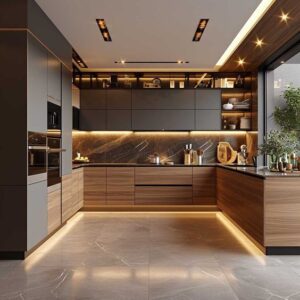
• Pick a color palette that goes well with the interior decor of your house.
• For a modern appearance, use a style that is uncluttered and clean.
• For visual appeal, choose contrasting hues for counters and cabinetry.
• For a feeling of modernity, go for a clean, minimalist style.
• Choose knobs and handles that improve the appearance of the kitchen.
• Maintain consistency in the design for a unified appearance.
• For style, add ornamental features like backsplashes.
• For a timeless appearance, think about natural wood finishes.
• Glass cabinets provide an elegant, airy appearance.
• Add unique finishing touches, such as lighting or tiling.
10. Safety precautions
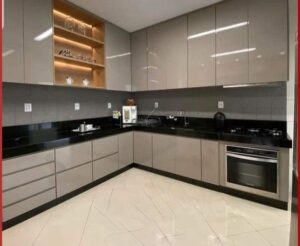
• To avoid mishaps, install flooring that is not prone to slipping.
• Make sure cabinets and countertops have rounded edges.
• Store cutting tools, such as knives, in a secure location that is easy to reach.
• If there are young children living in the home, install child-proof locks.
• Make sure gas cylinders are positioned correctly, away from heat sources.
• Install fire extinguishers and smoke detectors as a precaution against fires.
• To prevent injury, install cabinets with soft-close mechanisms.
• Make sure to position electrical outlets far from sources of water.
• Keep combustible items away from places used for cooking.
• Maintain ventilation systems to lower the danger of heat and smoke.
You can guarantee that the finished product is both fashionable and functional, turning your kitchen into a useful and pleasurable room in your house, by taking five crucial factors into account before installing your modular kitchen.
Have questions about your next renovation project? We’ve got answers. Let’s do this together.
Follow House Beautiful on Instagram.
The ideal layout depends on your kitchen’s space and design preferences. Common layouts include L-shaped, U-shaped, straight-line, and island kitchens. A good layout ensures easy movement between the cooking, storage, and cleaning areas, forming an efficient work triangle.
Durable and easy-to-maintain materials are essential. Common materials for cabinets include MDF or plywood with laminate, acrylic, or glass finishes. Countertops are often made of granite, quartz, or solid surfaces. Ensure materials are heat- and moisture-resistant.
Use specialized storage solutions such as pull-out drawers, carousel units for corner spaces, and tall cabinets. Soft-close mechanisms, drawer organizers, and overhead storage can also help maximize space and improve accessibility.
The standard countertop height is usually between 34 and 36 inches. However, this can be adjusted based on the height of the person who uses the kitchen the most. Ergonomic height helps in reducing strain during cooking and food preparation.
Safety is crucial—install anti-slip flooring, round the edges of countertops, and ensure proper storage for sharp tools. Keep electrical outlets away from water, install smoke detectors, and place gas cylinders away from heat sources. Child-proof locks and fire extinguishers are additional safety features.




